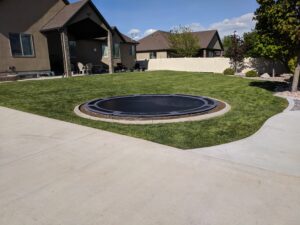What do you do if you want to install an in-ground or sunken trampoline in your yard but the only place to put it is on a slope? Do you still need a retaining wall? Is it safe?
Thankfully, it is possible to bury a trampoline on uneven ground but there are a few things you need to do in order for the installation to be safe and secure.
How to Install an In-Ground Trampoline on a Small Slope
The first thing to do is work out how much of a slope you’ve got. Most yards are not exactly level all over so it’s likely that if you’re installing an in-ground trampoline, it’s not going to be on a perfectly flat piece of ground. If you’re talking just a slight slope of a couple of degrees or some uneven ground, this does not present a major issue.
When you dig the hole to bury your trampoline, just make the side that’s on the higher slope slightly deeper. This will give a level, above-ground look and won’t impact on the trampoline’s functionality. For small slopes and uneven ground, you may also be able to adjust the legs on one side of the trampoline and use things like a leveling block under them to ensure stability. A retaining wall will also add to the stability of the trampoline frame in the ground and will ensure the surrounding soil will not fall back into the dug out pit.
Installing an In-Ground Trampoline on a Steep Slope
It is still possible to install an in-ground trampoline on a hill or steeper slope in your yard, there’s just a bit of extra work that needs to be done. The best option is to level out an area larger than the trampoline so it gradually blends into it. This is also known as “terracing”. Excavating this larger area may be a job for the professionals but you can also do it yourself. As well as creating enough space to lay the trampoline flat, the grading of the hill means that it’s also safer and easier for jumpers to use the mat.
Retaining Walls for In-Ground Trampolines on a Hill
Retaining walls are always important when you install an in-ground trampoline, but if you’re putting one on a slope, they are a must. Retaining walls, whether a kit specific to a brand of trampoline or built yourself, hold back soil from falling back into the trampoline pit and maintain the integrity of the landscaping around the trampoline. This is especially important if the hole you dig is on a steep slope. Elevated retaining walls built on the lower part of the slope will help you level out and stabilize your equipment.
Why Must a Trampoline Be Level?
An in-ground trampoline that’s out of being perfectly level by a degree or two isn’t going to make any difference to the visuals, safety or functionality of the trampoline but any more than this and you will need to make sure you’re taking the slope of the land properly into account. This is because:
- A jumping mat that isn’t level can cause injuries through unsafe and unpredictable bouncing.
- There will be greater wear and tear on the lower part of the trampoline springs, mat and frame due to uneven weight distribution.
- Over time, jumping on an unbalanced or uneven trampoline may cause it to start sliding or moving down the sloped ground.
Prepare the ground properly, add your retaining walls and install the trampoline as level as possible for many years of bouncing fun.


